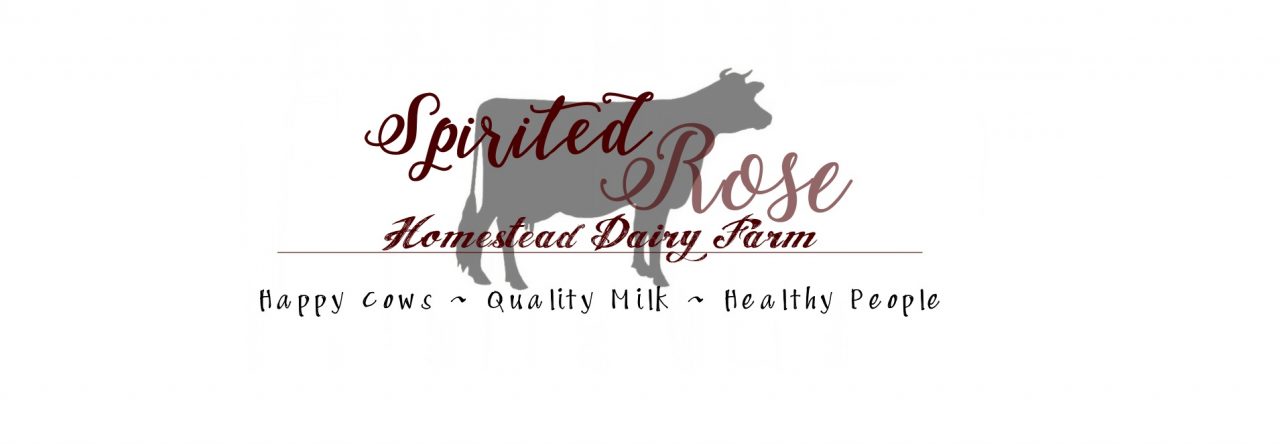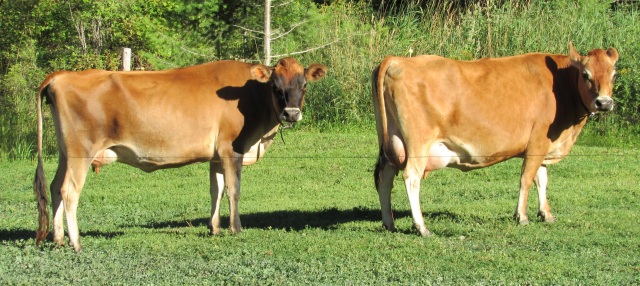I am often asked how our cows came to be and how can others find cows like ours.
I found my cows when I found my husband, a dairy farmer. As for the quality of cows and breeding future good cows, we follow his philosophy of moderation. You may not be able to find an ideal cow to buy, but you can buy a nice cow and breed her to quickly improve and get an offspring closer to your ideal.
Breed Moderation
We look at a cow and list her positive traits and negative traits. Then we find a bull to balance her out. Our current cow, Briar, is a taller/longer/Canadian style Jersey:
So we look for a bull that will bring down her size, making a more compact offspring, closer to the historic Island of Jersey type cow. We can do that by using New Zealand bloodlines:
Say your cow has a really sloped rump angle – you can look for bulls with good reliability for steeper rump angle that will offset that issue in your cow. Teat length is another good example. A lot of Jerseys have tiny teats, too small for hand milking. You can look for bulls that will increase teat length in their offspring.
Breed Up
Pick bulls to breed your cows to that will help you reach your “ideal cow” faster.
People often see a “breed standard” or a “breed average” and assume that describes 100% of animals from within a breed. A standard, by definition, is an ideal set of traits that each animal within the breed is compared to. For Jerseys, an appraisal system measures type (body conformation) traits and the DHIA program records milk production. Those two systems can be used to compare an individual animal to a breed standard. Breed average is simply that: The average among the individuals. For example, take the fat content of all Jersey cows and divide by the number of cows, you’ll get a number somewhere around 4.6-5.0% butterfat. But, that is simply an average – not taking into account the cows that give 6% milk or the cows that give 3.5% milk.
How I interpret this: When choosing bulls, I look at the DHIA records of the maternal lines. I look for cows producing milk over 5% butterfat, over 3.5% protein, and ideally under 14,000 lb. in first lactation/under 16,000 lb. in adult lactations. These are traits I consider part of the traditional Jersey breed standard.
As an example, our cow Briar is bred to Stellar. His maternal line is all over 6.0% butterfat which is super rare to find these days.
Breed purity
Within the Jersey breed, there are two separate standards: Purebred Jerseys and Commercial Jerseys. When buying or breeding a cow, I focus on purebred standards. Does this cow or this bull closely match the standards of a purebred Jersey cow?
How I interpret this: BBR, pedigree, and avoidance of JX in the pedigree are all ways to measure purity.
When starting out: My first cow was registered and purebred, as was her daughter. I had Jersey Origins collect their pedigree, showing all of their ancestors as far back as records go. I keep that book as records and as a reminder to maintain purebred status in their offspring to the best of my ability. I only use BBR 100 sires that have no JX anywhere in their pedigree, to the best of my knowledge. (Note, the NZ lines do not measure BBR, so you can use NZ websites/sire info to identify purity.)
I can go online to InfoJersey.com to research pedigrees. CDN.ca is another website that allows you to review bull pedigrees to a certain extent. Some breeds are much harder to research than others. If you have a Jersey and have questions, let me know, I can help interpret your cow’s information.

Breed down
The modern Jersey cow is primarily a Commercial Jersey. Purebred is becoming an outlier. A true purebred Jersey cow is as at risk as most other minor dairy breeds and other heritage breeds. In a modern context, I “breed down” or “breed backwards” because I look to the past for older bloodlines or modern bloodlines maintaining historical traits (like the New Zealand/grass based genetics).
How I interpret this: We keep old bulls in the AI tank (from the 50’s and 60’s) that we sometimes breed our cows to. Rosita (lighter cow on the right) is from a bull born in 1968. She is built very differently to her modern counterpart Briar (on the left). Rosita peaked at 3.5 gallons or so of milk and did not need grain to maintain body condition – those are traits not common to the modern Jersey!
Those are some of the ways we genetically create long lived cows. Of course, management plays a huge role as well. One doesn’t work without the other.







Excellent article / information, as usual. I love Rosita’s body type and beautiful udder, but I admit I am after more production. I don’t register my animals any more, and I am grateful to you and others who keep those superior genetics alive! You and Jay are a treasured resource.
LikeLike
That’s the fun thing about modern AI, there are bulls to meet everyone’s expectations. 🙂
LikeLike